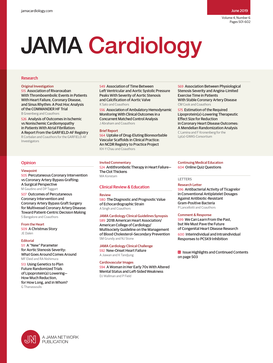Noninvasive Anatomical and Functional Imaging for Hemodynamic Relevance in Right Coronary Artery Anomalies.
IF 14.1
1区 医学
Q1 CARDIAC & CARDIOVASCULAR SYSTEMS
引用次数: 0
Abstract
Importance Right anomalous aortic origin of a coronary artery (R-AAOCA) is a rare congenital condition increasingly diagnosed with the growing use of cardiac imaging. Due to dynamic compression of the anomalous vessel, invasive fractional flow reserve (FFR) during a dobutamine-atropine volume challenge (FFR-dobutamine) is considered the reference standard. A reliable alternative method is needed to reduce extensive invasive testing, but it remains uncertain whether noninvasive imaging can accurately assess the hemodynamic relevance of R-AAOCA. Objective To evaluate the diagnostic performance of noninvasive anatomical and functional cardiac imaging to determine the hemodynamic relevance of R-AAOCA compared with the FFR-dobutamine reference standard. Design, Setting, and Participants This was a prospective, single-center cohort study performed between June 2020 and January 2025. The study was conducted at a specialized coronary artery anomaly clinic in Bern, Switzerland. Consecutive adult patients with R-AAOCA with an interarterial/intramural course and a right coronary dominance were included in the study. Interventions All patients underwent coronary computed tomography angiography (CCTA), nuclear cardiac imaging, and invasive FFR-dobutamine testing. Main Outcomes and Measures Hemodynamic relevance of the anomalous vessel was defined as an FFR-dobutamine value less than or equal to 0.8. Patients with stenotic atherosclerotic plaques in the anomalous vessel at the time of functional testing were excluded. Results A total of 55 patients (mean [SD] age, 51 [12] years; 37 male [67%]) with newly detected R-AAOCA and combined interarterial/intramural course were included in the analysis. Median FFR-dobutamine was 0.87 (IQR, 0.80-0.91), and 15 cases (27%) were hemodynamically relevant (ie, FFR-dobutamine ≤0.8). Anatomical CCTA (ie, CCTA-ostial minor axis) assessment demonstrated both a 100% sensitivity and negative predictive value with a receiver operating characteristic curve of 0.82, as well as a specificity of 57%, leading to rule out 23 cases (42%; ie, 58% of the hemodynamic nonrelevant cases). Functional nuclear imaging detected ischemia in 4 patients (7%; ie, 27% of hemodynamically relevant cases, all true positive, none false positive), resulting in a sensitivity of 27%, both specificity and positive predictive value of 100%, and an accuracy of 80% in predicting FFR-dobutamine less than or equal to 0.8. Conclusions and Relevance Results of this cohort study suggest that in adults with R-AAOCA, a multimodality diagnostic imaging approach applicable in a stepwise manner, starting with CCTA, which offers high diagnostic performance to exclude hemodynamic relevance-and optionally complemented by functional imaging with modest diagnostic performance to rule in hemodynamic relevance-may help to reduce the need for invasive testing to a subset of patients.右冠状动脉异常血流动力学相关性的无创解剖和功能成像。
摘要:右冠状动脉异常起源(R-AAOCA)是一种罕见的先天性疾病,随着心脏影像学的应用越来越广泛,诊断越来越多。由于异常血管的动态压缩,多巴酚丁胺-阿托品容积挑战(FFR-多巴酚丁胺)期间的有创分数血流储备(FFR)被认为是参考标准。需要一种可靠的替代方法来减少广泛的侵入性检查,但非侵入性成像是否能准确评估R-AAOCA的血流动力学相关性仍不确定。目的评价无创心脏解剖和功能影像学诊断R-AAOCA与ffr -多巴酚丁胺参考标准的血流动力学相关性。设计、环境和参与者这是一项在2020年6月至2025年1月间进行的前瞻性单中心队列研究。这项研究是在瑞士伯尔尼的一家专门的冠状动脉异常诊所进行的。连续的成年R-AAOCA患者伴有动脉间/壁内病程和右冠状动脉优势被纳入研究。干预措施:所有患者均接受冠状动脉计算机断层血管造影(CCTA)、心脏核成像和有创ffr -多巴酚丁胺检测。血流动力学相关性定义为ffr -多巴酚丁胺值小于或等于0.8。排除功能检查时异常血管内有狭窄性动脉粥样硬化斑块的患者。结果共纳入55例新检R-AAOCA合并动脉间/壁内病程的患者(平均年龄51岁,男性37例,67%)。中位ffr -多巴酚丁胺为0.87 (IQR, 0.80-0.91), 15例(27%)与血流动力学相关(即ffr -多巴酚丁胺≤0.8)。解剖CCTA(即CCTA-口小轴)评估的敏感性为100%,阴性预测值为0.82,特异性为57%,排除23例(42%,即58%的血流动力学不相关病例)。4例(7%,即占血流动力学相关病例的27%,均为真阳性,无假阳性)的功能性核成像检测出缺血,其敏感性为27%,特异性和阳性预测值均为100%,预测ffr -多巴酚丁胺小于等于0.8的准确率为80%。结论和相关性本队列研究的结果表明,对于患有R-AAOCA的成人患者,多模式诊断成像方法可逐步应用,从CCTA开始,CCTA提供高诊断性能以排除血流动力学相关性,并选择性地辅以具有中等诊断性能的功能成像来确定血流动力学相关性,这可能有助于减少对一部分患者进行侵入性检查的需要。
本文章由计算机程序翻译,如有差异,请以英文原文为准。
求助全文
约1分钟内获得全文
求助全文
来源期刊

JAMA cardiology
Medicine-Cardiology and Cardiovascular Medicine
CiteScore
45.80
自引率
1.70%
发文量
264
期刊介绍:
JAMA Cardiology, an international peer-reviewed journal, serves as the premier publication for clinical investigators, clinicians, and trainees in cardiovascular medicine worldwide. As a member of the JAMA Network, it aligns with a consortium of peer-reviewed general medical and specialty publications.
Published online weekly, every Wednesday, and in 12 print/online issues annually, JAMA Cardiology attracts over 4.3 million annual article views and downloads. Research articles become freely accessible online 12 months post-publication without any author fees. Moreover, the online version is readily accessible to institutions in developing countries through the World Health Organization's HINARI program.
Positioned at the intersection of clinical investigation, actionable clinical science, and clinical practice, JAMA Cardiology prioritizes traditional and evolving cardiovascular medicine, alongside evidence-based health policy. It places particular emphasis on health equity, especially when grounded in original science, as a top editorial priority.
 求助内容:
求助内容: 应助结果提醒方式:
应助结果提醒方式:


